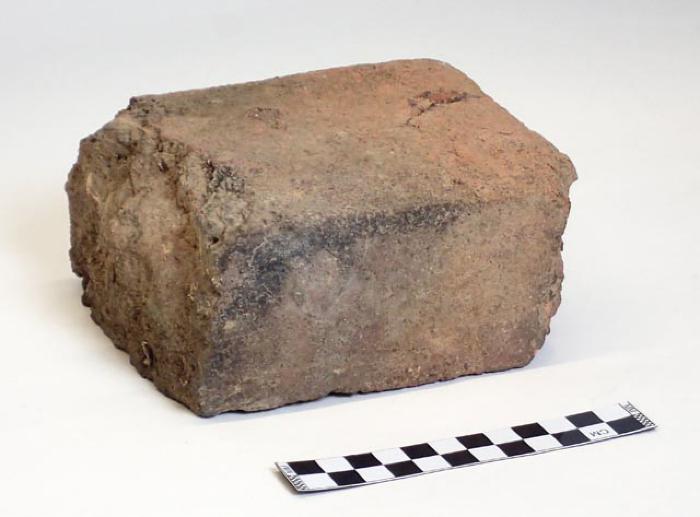Brick — TRipiitsaaq
TRipiitsaalitaallriit qikumek. – They used to make bricks out of clay.

Photo: Historic brick from Long Island kiln, gift of Perry Eaton.
Brick-making was one of the industries Russian traders established in Alaska to provide essential supplies to colonies far from European supplies. Russian colonists used bricks to build stoves and ovens, and although some bricks were imported to Alaska, it was more economical to make these heavy building materials in Alaska.
There were nine brick kilns in Russian America, including two in the Kodiak area–one on Long Island and another in Middle Bay. Here thousands of bricks were made for both local use and shipment to places like Sitka. In the 1820s, Russian colonists and Alutiiq laborers produced about 30,000 bricks annually on Kodiak. They made the bricks from local clay and lime produced by burning shells. Unfortunately, the resulting bricks were of poor quality. Seawater made the bricks porous and many crumbled. As such, Kodiak bricks were only used where they were badly needed.
In 1964, a local rancher found the Middle Bay brick kiln and reported it to archaeologist Don Clark. Erosion and road construction had exposed a part of the kiln, originally manufactured in August of 1828. Archaeological excavations show that the feature had a post and beam structure around it for protection and a storage barn, clay mixing pit, and workers' quarters nearby. The kiln was about 16 feet square and of Roman design. Arches supported the floor of the kiln and provided a place beneath it for the fire. Vents allowed the heat to flow into the kiln and around the baking bricks to promote an even firing.
There were nine brick kilns in Russian America, including two in the Kodiak area–one on Long Island and another in Middle Bay. Here thousands of bricks were made for both local use and shipment to places like Sitka. In the 1820s, Russian colonists and Alutiiq laborers produced about 30,000 bricks annually on Kodiak. They made the bricks from local clay and lime produced by burning shells. Unfortunately, the resulting bricks were of poor quality. Seawater made the bricks porous and many crumbled. As such, Kodiak bricks were only used where they were badly needed.
In 1964, a local rancher found the Middle Bay brick kiln and reported it to archaeologist Don Clark. Erosion and road construction had exposed a part of the kiln, originally manufactured in August of 1828. Archaeological excavations show that the feature had a post and beam structure around it for protection and a storage barn, clay mixing pit, and workers' quarters nearby. The kiln was about 16 feet square and of Roman design. Arches supported the floor of the kiln and provided a place beneath it for the fire. Vents allowed the heat to flow into the kiln and around the baking bricks to promote an even firing.
